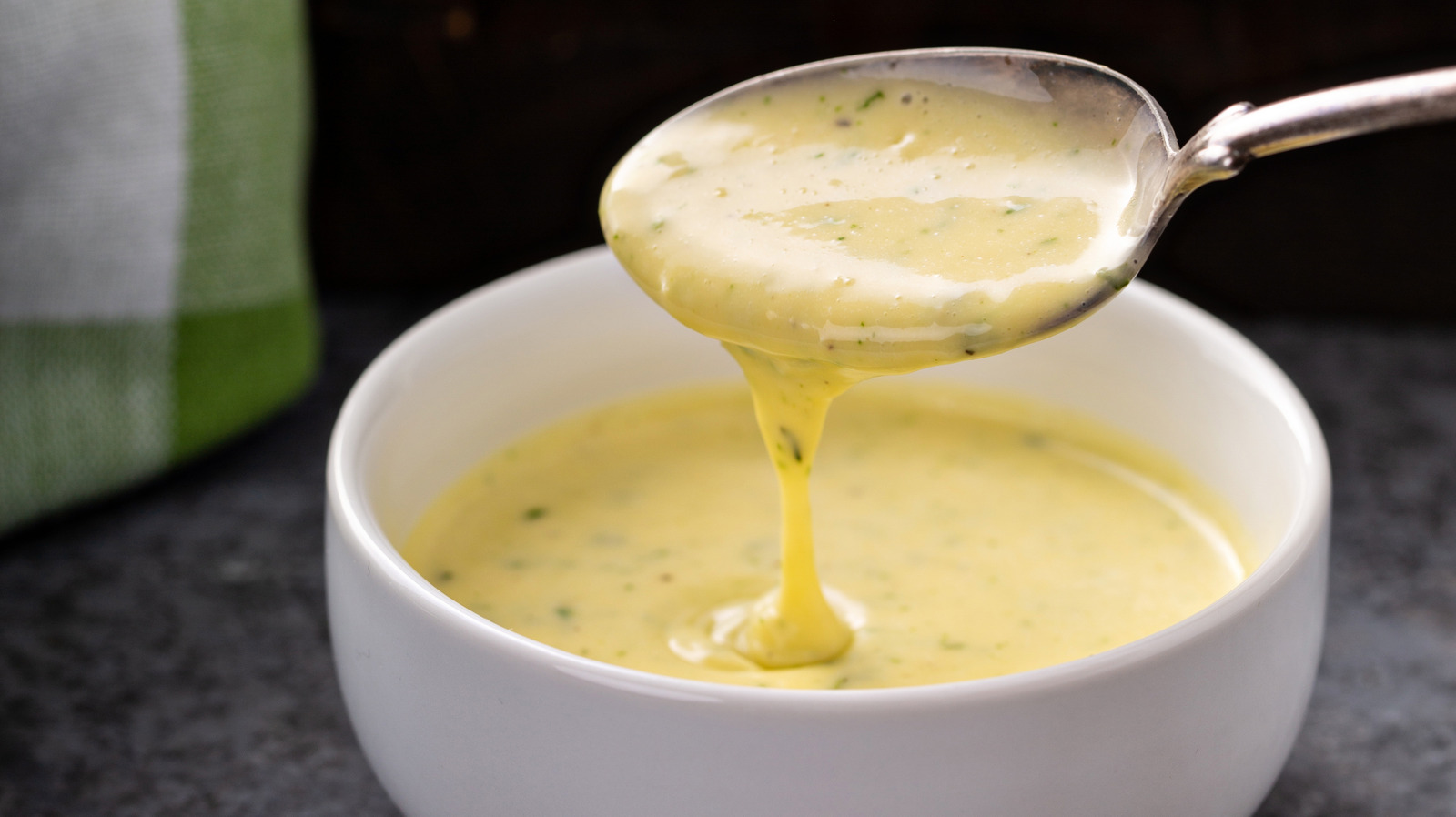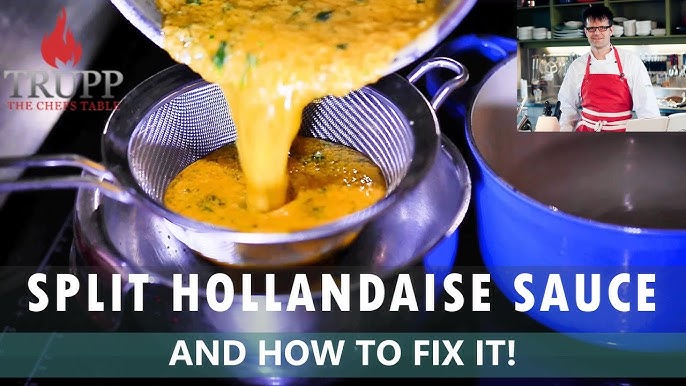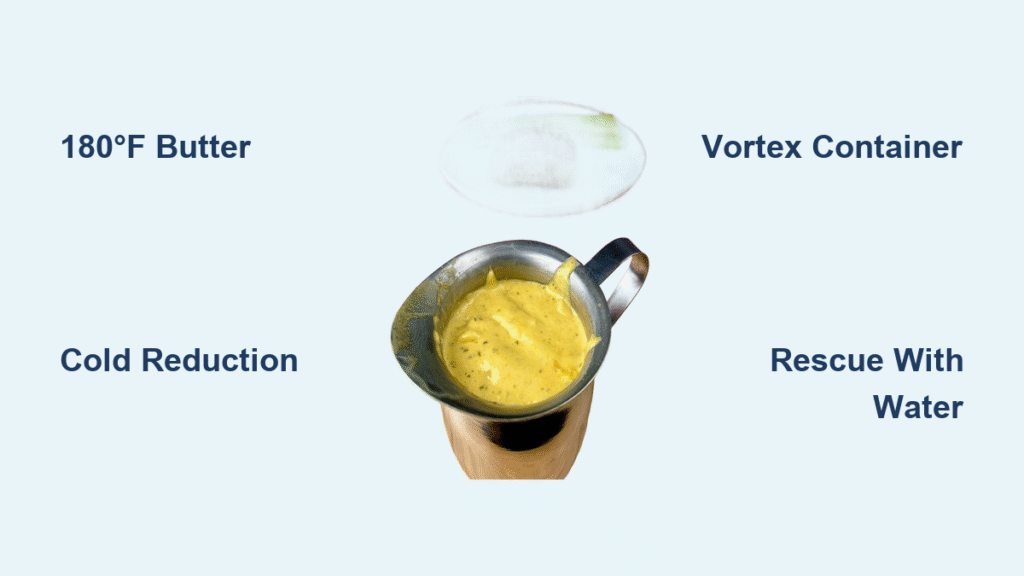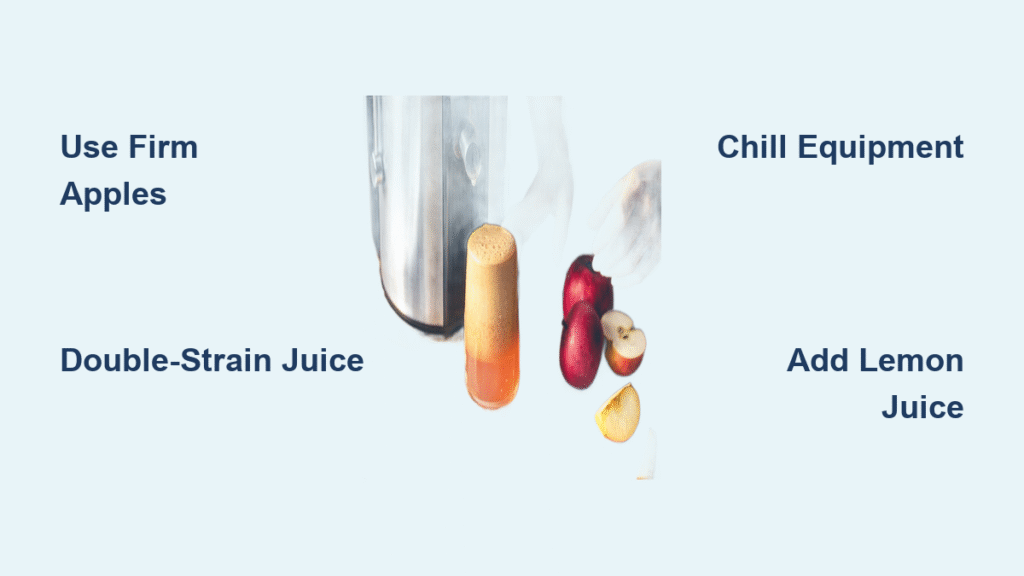That dreamy, herb-flecked béarnaise sauce you crave with grilled steak no longer requires restaurant skills or endless whisking. With your immersion blender, this once-temperamental French classic becomes achievable in under 25 minutes—delivering silky, restaurant-quality results without the stress. The secret lies in how the immersion blender’s vortex action creates instant emulsification, eliminating the risk of scrambled eggs or broken sauces that plague traditional methods. You’ll master the critical 180°F butter temperature, learn why container geometry matters more than technique, and discover the single rescue move for split sauces. Most importantly, you’ll have a glossy, tarragon-infused béarnaise ready before your steak rests.
This immersion blender béarnaise method cuts traditional prep time by 60% while preserving every authentic flavor note: the bright tarragon, subtle shallot depth, and perfect richness-acidity balance. No more hovering over a double boiler—just controlled pouring and precise temperatures. The result? A sauce that coats your spoon luxuriously and elevates even weeknight dinners to special-occasion status.
Béarnaise vs Hollandaise: Why Tarragon Changes Everything
Hollandaise relies solely on lemon juice for acidity, creating a bright but one-dimensional sauce. Béarnaise transforms this foundation with a white wine vinegar and tarragon reduction, adding complex savory notes that complement red meat perfectly. This flavor base swap is the only difference between the two sauces—making the immersion blender technique universally applicable to both.
The reduction process concentrates the vinegar, shallot, and tarragon into an intensely flavored liquid. As it simmers down to just 2 tablespoons, the shallot’s sweetness melds with tarragon’s anise-like notes, replacing lemon’s sharpness with rounded depth. Crucially, making this reduction ahead actually improves your béarnaise, as the flavors continue developing while cooling.
Essential Ingredients for Bulletproof Emulsions
Core Components That Can’t Be Skipped
- 3 large room-temperature egg yolks: Cold yolks resist emulsification, leading to thin sauce
- 16 tablespoons unsalted butter: Melted to exactly 180°F for optimal emulsion stability
- ½ cup white wine vinegar: Reduces to 2 tablespoons of concentrated flavor base
- 2 fresh tarragon sprigs plus 1½ tablespoons minced: Provides layered herbal notes
- 1 thinly sliced shallot: Maximizes surface area for flavor extraction
- 1½ teaspoons lemon juice: Adds necessary acidity without vinegar sharpness
- ¼ teaspoon salt plus pinch of cayenne: Balances richness and enhances complexity
Quality Indicators for Success
Select deep golden egg yolks—they create richer emulsions than pale supermarket varieties. European-style butter with higher fat content (like Kerrygold) produces superior texture. Fresh tarragon should release a distinct anise aroma when crushed; dried substitutes fail to deliver béarnaise’s signature flavor. Always use unsalted butter to control sodium levels precisely.
Quick Reduction Method for Maximum Flavor
Build Flavor Base Efficiently
Combine the ½ cup white wine vinegar, 2 tarragon sprigs, and thinly sliced shallot in a small skillet. The wide surface area accelerates reduction while allowing the shallot to fully release its sugars into the acidic liquid—creating the sauce’s foundational complexity in minutes.
Reduce to Concentrate Intensity
Simmer uncovered over medium heat for 5-7 minutes until liquid reduces to exactly 2 tablespoons. The mixture should coat the back of a spoon and taste intensely of tarragon with subtle shallot sweetness. Never reduce beyond this point—over-reduction concentrates excessive acidity and salt.
Cool Slightly Before Adding
Let the reduction rest for 2-3 minutes off-heat. It must be warm but not hot enough to scramble egg yolks (ideal: 110-120°F). Test by touching a drop to your wrist—it should feel comfortably warm, not scalding. This critical cooling window prevents premature egg coagulation.
Butter Temperature: The Non-Negotiable 180°F Rule

Measure Precisely With Thermometer
This temperature is non-negotiable. At 180°F, the butter gently cooks the egg yolks while creating stable emulsion bonds. Cooler butter won’t emulsify properly; hotter than 185°F risks scrambling. A digital thermometer eliminates guesswork—your single most important tool for béarnaise success.
Control Pouring With Spouted Cup
Transfer melted butter to a spouted measuring cup immediately after melting. The narrow spout enables the paper-thin stream essential for gradual fat incorporation. Pouring directly from a bowl overwhelms the egg yolks with excessive fat too quickly—guaranteeing separation.
Maintain Heat During Process
Butter cools rapidly—work efficiently. If temperature drops below 160°F during pouring, briefly reheat in 5-second microwave intervals. Test by dripping a small amount on your inner wrist; it should feel hot but not painful. Never restart the reduction process once emulsification begins.
Immersion Blender Technique for Instant Emulsification
Container Selection Matters Most
Use a 2-cup liquid measuring cup—its narrow 2.5-inch diameter creates the optimal vortex for emulsification. Wider containers disperse the blender’s power, yielding thin sauce. The clear sides let you monitor texture changes in real-time as the sauce thickens.
Base Combination Setup
Add the cooled reduction, 3 egg yolks, 1½ tsp lemon juice, ¼ tsp salt, and cayenne pinch to the measuring cup. Insert the immersion blender horizontally against the bottom before starting—this prevents splattering and ensures even initial blending.
The 30-Second Emulsion Process
Start blending at medium speed for 5 seconds to combine yolks with reduction. Immediately begin pouring hot butter in the thinnest possible stream down the container’s side. Watch as the mixture turns pale yellow and thickens within 15 seconds. Continue blending while pouring until all butter incorporates—total emulsification takes just 30 seconds. Stop when sauce coats a spoon luxuriously.
Troubleshooting Common Failures

Sauce Too Thin? Fix in 60 Seconds
Cause: Butter added too quickly or below 160°F
Fix: Blend in additional hot butter (1 tbsp at a time) until sauce thickens. Proper béarnaise should slowly drip from a spoon—never runny. If over-thinned, add 1 tsp warm water to restart emulsification.
Split or Curdled Sauce? Rescue Instantly
Cause: Butter too hot or poured too fast
Fix: Place 1 tbsp warm water in a clean container. With immersion blender running at the bottom, slowly drizzle in the broken sauce. The water creates a new emulsion base—your sauce will reconstitute within 20 seconds.
Overly Salty? Balance in Seconds
Cause: Reduction boiled too long
Fix: Whisk in 1-2 tbsp warm water to dilute. Add a tiny pinch of sugar to counterbalance excessive saltiness without adding sweetness. Always season reduction conservatively—it concentrates during cooking.
Flavor Adjustments for Perfect Balance
Classic Seasoning Protocol
Fold in 1½ tbsp minced tarragon after emulsification—heat destroys its delicate flavor. Adjust salt incrementally; the reduction concentrates sodium. Cayenne should provide subtle warmth, not heat—add in microscopic pinches.
Herb Variations That Work
Replace half the tarragon with fresh chervil for a more floral profile. Add ½ tsp Dijon mustard during emulsification for nuanced complexity. Minced parsley brightens color without altering flavor—ideal for brunch versions.
Dietary Adaptations That Hold
Substitute ghee for butter in paleo versions—the technique remains identical. Lactose-free butter works perfectly for sensitive diners. Never replace fat content—béarnaise requires full-fat dairy for proper emulsion structure.
Serving and Storage Without Sacrificing Quality
Immediate Service Protocol
Serve within 30 minutes for peak texture. Keep warm (not hot) by placing the container in a bowl of 110°F water—never direct heat. Stir gently before serving; immersion blender béarnaise thickens slightly as it stands.
Refrigeration That Preserves Texture
Store leftovers in the refrigerator door (warmest spot) for up to 3 days. Solidified sauce reheats beautifully: microwave in 5-second bursts, stirring between intervals until just pourable. Never reheat above 140°F.
Unexpected Perfect Pairings
Beyond steak, try over seared scallops or roasted asparagus. Elevates eggs Benedict with French flair. Transforms grilled chicken into an elegant entrée—simply spoon over before serving.
Pro Tips for Consistent Restaurant Results
Prep Ahead Strategy
Make the reduction up to 3 days ahead—store covered in the fridge. Pre-measure dry ingredients into ramekins. With mise en place ready, sauce comes together in under 5 minutes when guests arrive.
Equipment Shortcuts That Work
No immersion blender? Use a regular blender with center cap removed. Stream butter through the opening while blending on low—requires slower pouring but achieves identical results.
Scaling Secrets
This recipe doubles perfectly—use a 4-cup container and maintain identical butter temperature. For half-batches, reduce all ingredients proportionally but keep the same pouring speed and container diameter.
Final Flavor Balance Check Before Serving
Taste your béarnaise immediately before serving. It should coat your tongue with luxurious weight while tarragon and shallot notes dance across your palate. Acidity must cut richness without sharpness—adjust with single drops of lemon juice or microscopic salt pinches. When perfectly balanced, the sauce will make your steak taste expensive. This immersion blender method transforms béarnaise from a kitchen nightmare into your most reliable showstopper—no whisking required.





